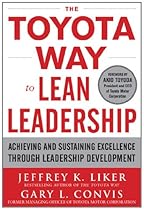Chapter 1 of The Toyota Way to Lean Leadership is titled “Leading in the Toyota Way: A Lifelong Journey.”
It seeks to draw a sharp contrast between Toyota’s leadership model and the model that is taught and practiced in a more “traditional” Western company.
Where the “teaching” process in a traditional company tends to be tacit – reinforcing some behaviors and discouraging others, in the Toyota described by Liker and Convis, the process is far more deliberate.
It is a process of aligning to explicitly stated core values that have been in practice since the inception of the company, but only written down in 2001 as The Toyota Way 2001.
Then, because the word “leadership” often carries one of those “I know it when I see it” kinds of definitions, the authors use examples and construct a model to describe what they have observed. That model then structures the next few chapters (Yes, I peeked ahead).
Across the chapter they are describing leadership, not as something practiced by individuals, but as an interdependent ecosystem that links tightly to every aspect of the company. Certainly individuals each have their own style, but it is expressed within a context defined by commonly held beliefs and norms of behavior that combine to form what we call a “culture.”
Someone from outside that culture (such as Gary Convis coming from Ford, and other Toyota managers I have known personally), has to work hard to assimilate into it.
Outside the context of the book, I have also seen the opposite: Take someone who knows nothing but the Toyota culture and put them into a “traditional” company and many of them have a hard time adapting to a completely alien environment. The support structures they are used to are simply not there, and it can be psychologically very isolating.
One example of this contrast is in how these two systems see “Challenge.”
In a traditional company, a “challenge” is issued as a “stretch goal” and it is up to the individual to figure out on their own how to meet it. In the most extreme case of an “only results matter” environment, they may disregard their fellow team members, rules, ethics, even the law to get there. While we have spectacular examples such as Enron, there are lots of companies where “inventory targets” are met by starving off production at the end of the quarter and pulling in orders from the next.
“Challenge” is one of the explicit values in The Toyota Way 2001 but it looks quite different. Yes, there are challenges issued. But behind that challenge is a support structure. The leaders, at all levels are expected to stretch their own personal development, but to do so within the context of kaizen, deep understanding gained by genchi genbutsu, team work and most important of all, respect.
The leader’s development level is gauged by how the challenge is met even more than whether it is met. Just “get-r-done” doesn’t work here.

Mark,
I just finished this book and I too think it was very well written and thought provoking. I think if you take this book and Mike Rother’s Toyota Kata, you have two very good book ends for true Lean Leadership. It was a real eye opener for me when I look at how most companies train and promote leaders as compared to what Toyota does. No wonder they’re so successful!
Tom
Tom –
I also recommend the HBR article “Learning to Lead at Toyota” by Steven Spear. I have study guides for it on my Resources page (link in right sidebar —–> )